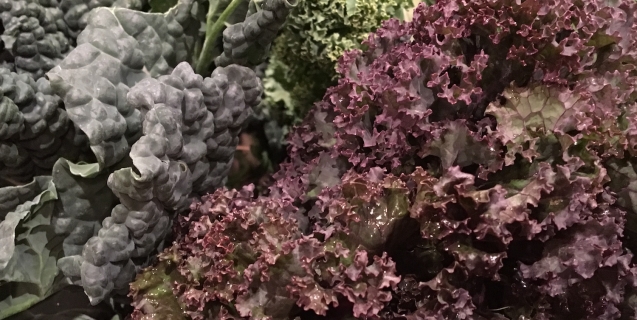
Kale Salad

It’s no wonder that kale is still a trendy vegetable, figuring prominently on menus around the country, after making its debut as the great Superfood nearly a decade ago. A member of the Brassica family, kale is low in calories, high in fiber, and nutrient-rich, supplying copious amounts of calcium, iron, Vitamins A, C, and K, as well as cancer-fighting antioxidants.
Varieties of kale differ in both flavor and appearance. All varieties tend to be a bit bitter, so choose the youngest leaves you can find. Kale ribs are tough and should be removed for nearly every recipe, certainly salads. Toss the stems or use them in soup broths.
Curly Kale, the most common variety, is bright or dark green with ruffled leaves. Its close cousin, Red Kale, has the same frilly appearance, but is dark red in color as its name suggests. Break the curly leaves into edible portions, toss them lightly with olive oil and salt, and bake them for 5 minutes. Children of all ages love this easy, healthy, and delicious snack—zero calorie kale chips.
Lacinato, also known as Dinosaur or Tuscan Kale, has dark blue-green, puckered leaves on long, slender stalks. This slightly sweeter kale was a staple in Jefferson’s Monticello garden and works well in salads, soups, and stews.
Red Russian Kale has flat, red-tinged leaves resembling those of the oak. Sweeter and tenderer than most kales, it is a good choice for salads and fruit smoothies. Just be sure to discard the tough, woody, fibrous stems.
Redbor Kale, a hybrid growing to 3 feet tall, resembles rainbow chard with its dark red stalks. Like Salad Savoy, the frilly cabbage-like rosette-forming kale, Redbor is grown mostly for ornamental purposes, though both types are edible and make pretty garnishes.
So, what’s the best variety of kale to use in preparing a salad? I have used both the curly and lacinato kales with equal success. I do recommend buying whole leaves as opposed to bagged greens because it is important to discard the ribs, and that is a much easier task when the kale is not pre-chopped. The other key to a good kale salad, in my opinion, is massaging the leaves. Massaging breaks down the cellulose structure and produces a sweeter, silkier kale. You may tear the leaves apart into bite-sized portions or use the French chiffonade technique–stacking, rolling, then slicing the leaves on the diagonal to form ribbons. Toss the the leaves with a little olive oil, salt, and lemon juice (optional dressing ingredients include minced garlic, red pepper flakes, Tamari, honey, parmesan cheese). Then, lovingly rub the leaves with your hands for about 5 minutes.
When adding ingredients to your salad, the choices are endless. I love a touch of citrus—orange or grapefruit slices. Apple, pear, and black currants are good fruit options as well. Avocado, sun-dried tomatoes, and feta cheese are popular additions. Toss seeds and/or nuts of any kind on top to add a delightful crunch. There is no right or wrong to a kale salad. Feast on the tastes you love the most and you will still receive plentiful goodness from the hearty greens that form the heart of your salad.
Resources:
“Popular Types of Kale and Their Health Benefits” http://www.onegreenplanet.org/popular-types-of-kale-and-their-health-benefits
“Ultimate Guide to Using Different Types of Kale” by Amy Sowder www.chowhound/food-news
Cate,
Great article on the review of kale as well as great ideas for endless possibilities when making a kale salad!
Thanks
Nice post! I like this recipe, it’s very healthy and easy to do. Thanks for sharing!/